Examining Threats to Independence in Auditing Practices in Australia
VerifiedAdded on 2020/04/01
|6
|1443
|30
AI Summary
The assignment centers around understanding and evaluating different types of threats to auditor independence through a series of case studies set within the Australian auditing framework. Students are tasked with classifying each scenario into categories such as self-review threat, familiarity or relationships threat, and self-interest threat, among others. The scenarios include situations like an audit team member previously employed by a client company, auditors receiving incentives from clients, and personal relationships between auditors and client employees. This exercise enhances comprehension of how various factors can compromise auditor objectivity and independence.
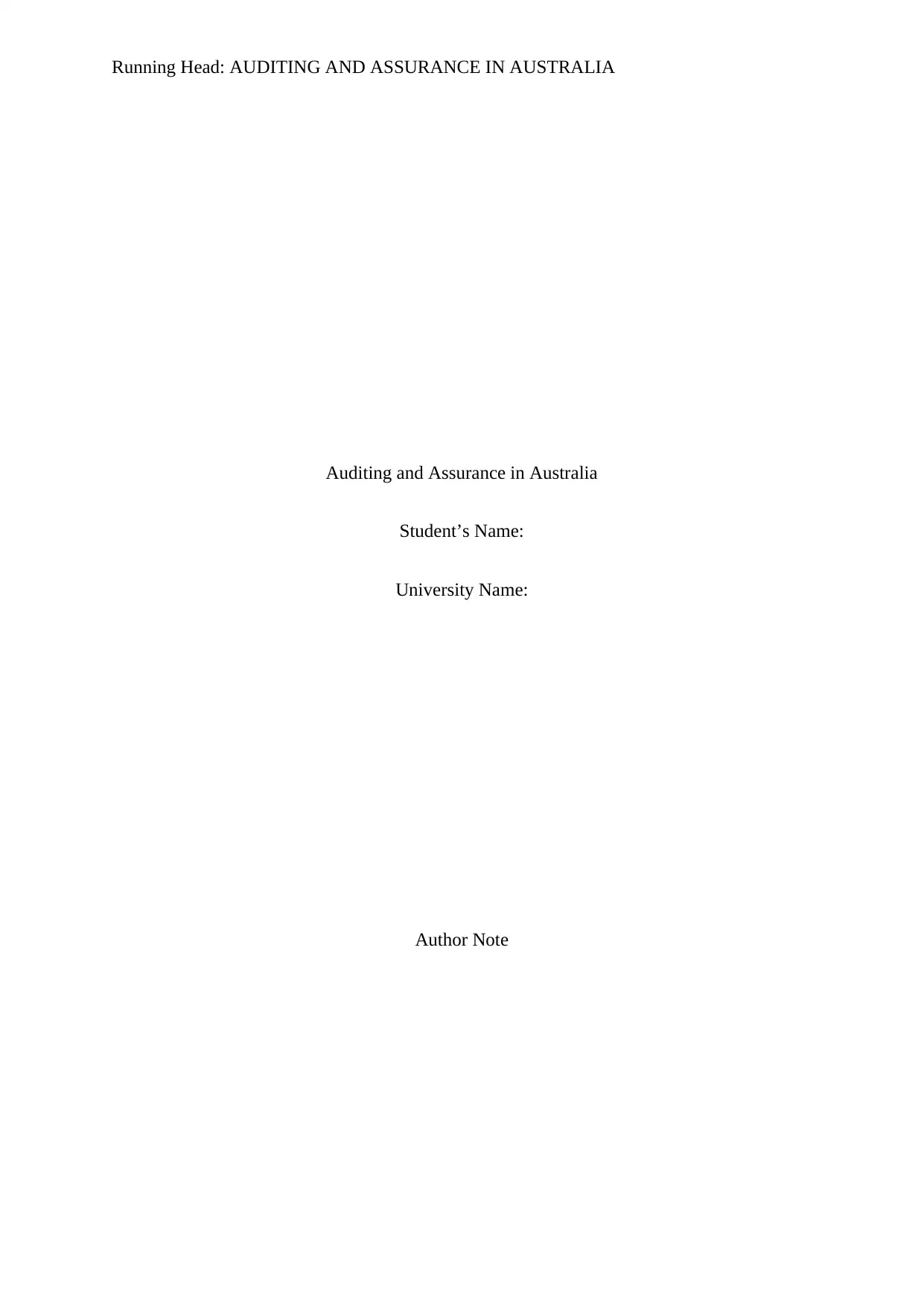
Running Head: AUDITING AND ASSURANCE IN AUSTRALIA
Auditing and Assurance in Australia
Student’s Name:
University Name:
Author Note
Auditing and Assurance in Australia
Student’s Name:
University Name:
Author Note
Paraphrase This Document
Need a fresh take? Get an instant paraphrase of this document with our AI Paraphraser
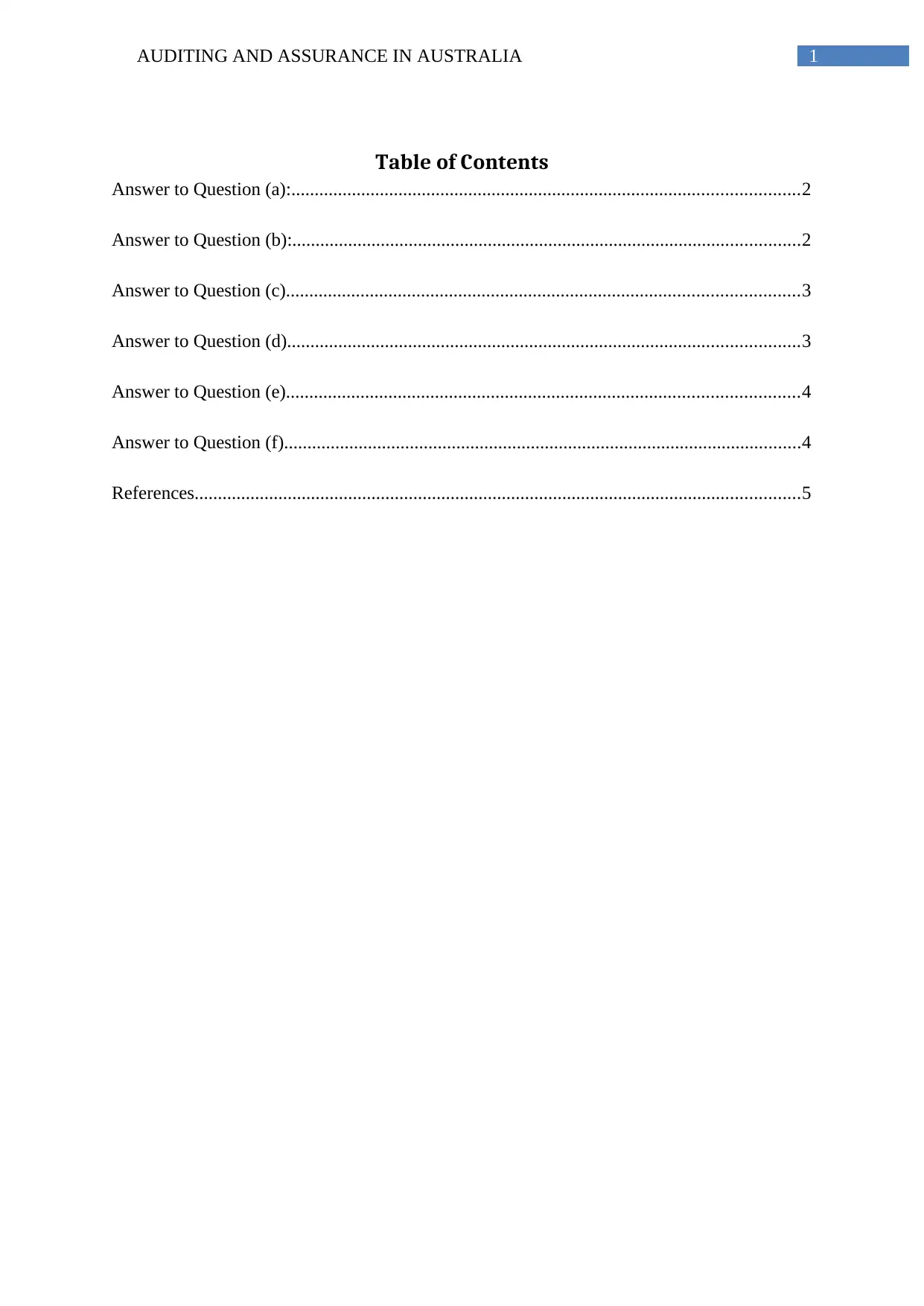
1AUDITING AND ASSURANCE IN AUSTRALIA
Table of Contents
Answer to Question (a):.............................................................................................................2
Answer to Question (b):.............................................................................................................2
Answer to Question (c)..............................................................................................................3
Answer to Question (d)..............................................................................................................3
Answer to Question (e)..............................................................................................................4
Answer to Question (f)...............................................................................................................4
References..................................................................................................................................5
Table of Contents
Answer to Question (a):.............................................................................................................2
Answer to Question (b):.............................................................................................................2
Answer to Question (c)..............................................................................................................3
Answer to Question (d)..............................................................................................................3
Answer to Question (e)..............................................................................................................4
Answer to Question (f)...............................................................................................................4
References..................................................................................................................................5
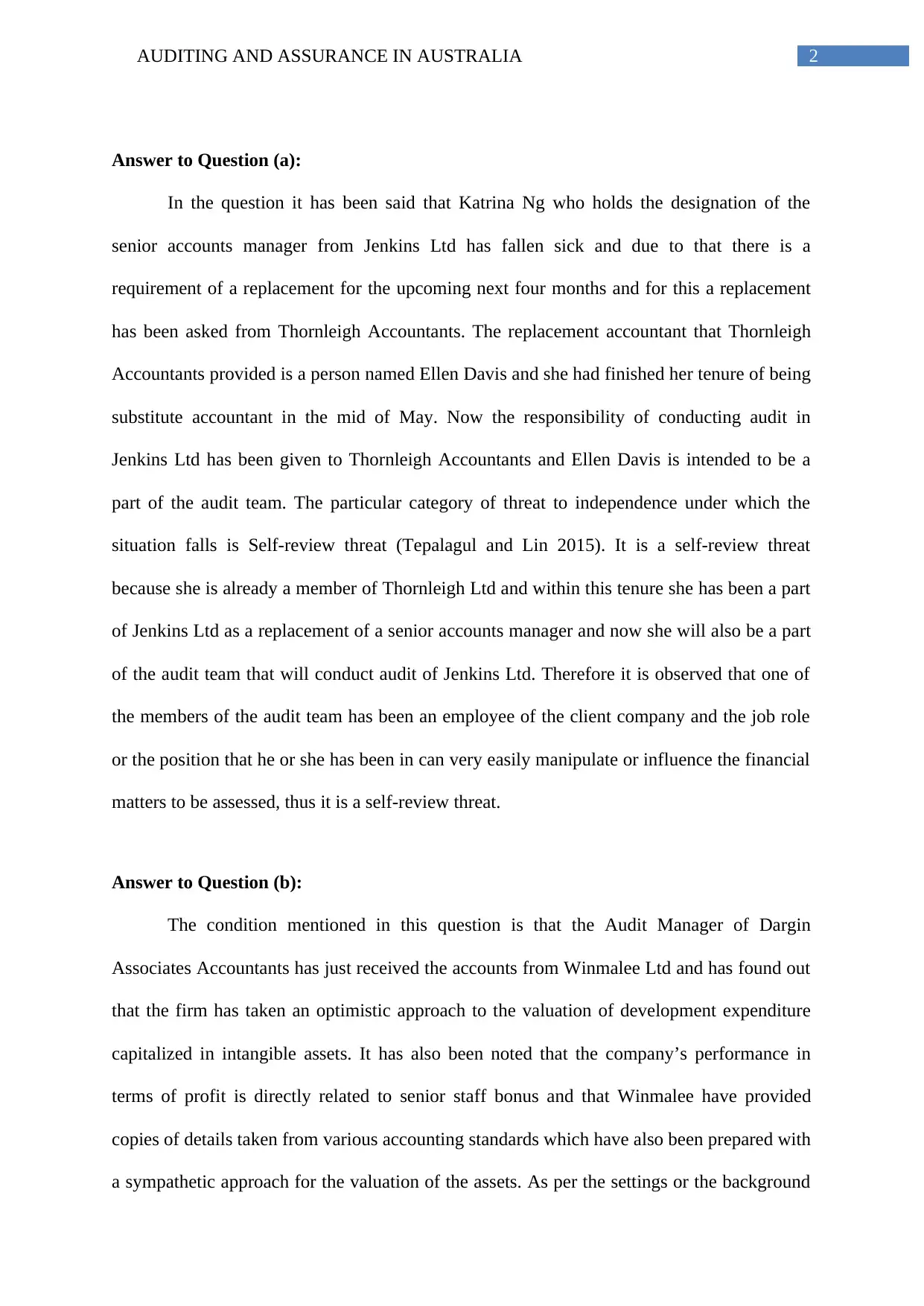
2AUDITING AND ASSURANCE IN AUSTRALIA
Answer to Question (a):
In the question it has been said that Katrina Ng who holds the designation of the
senior accounts manager from Jenkins Ltd has fallen sick and due to that there is a
requirement of a replacement for the upcoming next four months and for this a replacement
has been asked from Thornleigh Accountants. The replacement accountant that Thornleigh
Accountants provided is a person named Ellen Davis and she had finished her tenure of being
substitute accountant in the mid of May. Now the responsibility of conducting audit in
Jenkins Ltd has been given to Thornleigh Accountants and Ellen Davis is intended to be a
part of the audit team. The particular category of threat to independence under which the
situation falls is Self-review threat (Tepalagul and Lin 2015). It is a self-review threat
because she is already a member of Thornleigh Ltd and within this tenure she has been a part
of Jenkins Ltd as a replacement of a senior accounts manager and now she will also be a part
of the audit team that will conduct audit of Jenkins Ltd. Therefore it is observed that one of
the members of the audit team has been an employee of the client company and the job role
or the position that he or she has been in can very easily manipulate or influence the financial
matters to be assessed, thus it is a self-review threat.
Answer to Question (b):
The condition mentioned in this question is that the Audit Manager of Dargin
Associates Accountants has just received the accounts from Winmalee Ltd and has found out
that the firm has taken an optimistic approach to the valuation of development expenditure
capitalized in intangible assets. It has also been noted that the company’s performance in
terms of profit is directly related to senior staff bonus and that Winmalee have provided
copies of details taken from various accounting standards which have also been prepared with
a sympathetic approach for the valuation of the assets. As per the settings or the background
Answer to Question (a):
In the question it has been said that Katrina Ng who holds the designation of the
senior accounts manager from Jenkins Ltd has fallen sick and due to that there is a
requirement of a replacement for the upcoming next four months and for this a replacement
has been asked from Thornleigh Accountants. The replacement accountant that Thornleigh
Accountants provided is a person named Ellen Davis and she had finished her tenure of being
substitute accountant in the mid of May. Now the responsibility of conducting audit in
Jenkins Ltd has been given to Thornleigh Accountants and Ellen Davis is intended to be a
part of the audit team. The particular category of threat to independence under which the
situation falls is Self-review threat (Tepalagul and Lin 2015). It is a self-review threat
because she is already a member of Thornleigh Ltd and within this tenure she has been a part
of Jenkins Ltd as a replacement of a senior accounts manager and now she will also be a part
of the audit team that will conduct audit of Jenkins Ltd. Therefore it is observed that one of
the members of the audit team has been an employee of the client company and the job role
or the position that he or she has been in can very easily manipulate or influence the financial
matters to be assessed, thus it is a self-review threat.
Answer to Question (b):
The condition mentioned in this question is that the Audit Manager of Dargin
Associates Accountants has just received the accounts from Winmalee Ltd and has found out
that the firm has taken an optimistic approach to the valuation of development expenditure
capitalized in intangible assets. It has also been noted that the company’s performance in
terms of profit is directly related to senior staff bonus and that Winmalee have provided
copies of details taken from various accounting standards which have also been prepared with
a sympathetic approach for the valuation of the assets. As per the settings or the background
⊘ This is a preview!⊘
Do you want full access?
Subscribe today to unlock all pages.

Trusted by 1+ million students worldwide
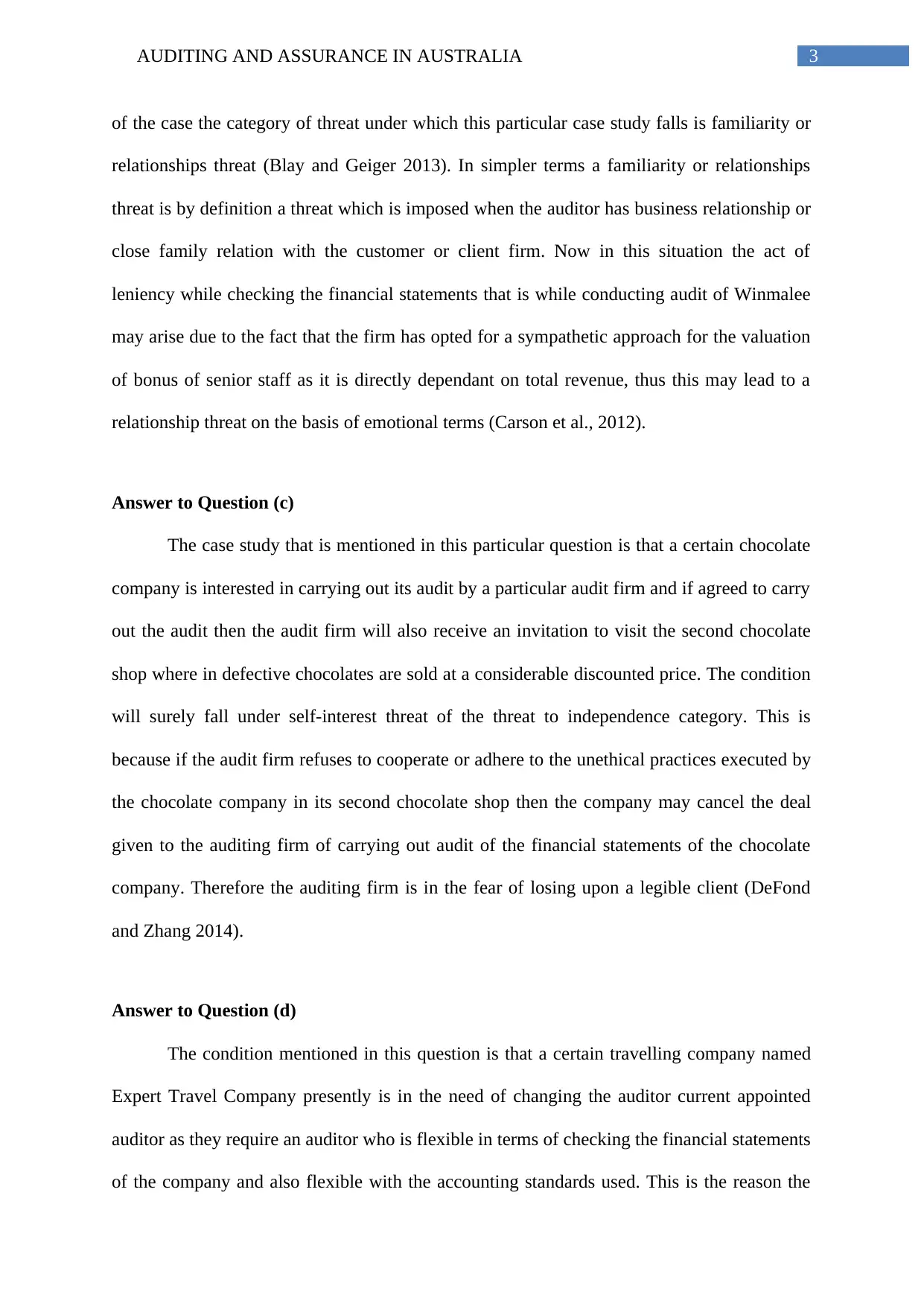
3AUDITING AND ASSURANCE IN AUSTRALIA
of the case the category of threat under which this particular case study falls is familiarity or
relationships threat (Blay and Geiger 2013). In simpler terms a familiarity or relationships
threat is by definition a threat which is imposed when the auditor has business relationship or
close family relation with the customer or client firm. Now in this situation the act of
leniency while checking the financial statements that is while conducting audit of Winmalee
may arise due to the fact that the firm has opted for a sympathetic approach for the valuation
of bonus of senior staff as it is directly dependant on total revenue, thus this may lead to a
relationship threat on the basis of emotional terms (Carson et al., 2012).
Answer to Question (c)
The case study that is mentioned in this particular question is that a certain chocolate
company is interested in carrying out its audit by a particular audit firm and if agreed to carry
out the audit then the audit firm will also receive an invitation to visit the second chocolate
shop where in defective chocolates are sold at a considerable discounted price. The condition
will surely fall under self-interest threat of the threat to independence category. This is
because if the audit firm refuses to cooperate or adhere to the unethical practices executed by
the chocolate company in its second chocolate shop then the company may cancel the deal
given to the auditing firm of carrying out audit of the financial statements of the chocolate
company. Therefore the auditing firm is in the fear of losing upon a legible client (DeFond
and Zhang 2014).
Answer to Question (d)
The condition mentioned in this question is that a certain travelling company named
Expert Travel Company presently is in the need of changing the auditor current appointed
auditor as they require an auditor who is flexible in terms of checking the financial statements
of the company and also flexible with the accounting standards used. This is the reason the
of the case the category of threat under which this particular case study falls is familiarity or
relationships threat (Blay and Geiger 2013). In simpler terms a familiarity or relationships
threat is by definition a threat which is imposed when the auditor has business relationship or
close family relation with the customer or client firm. Now in this situation the act of
leniency while checking the financial statements that is while conducting audit of Winmalee
may arise due to the fact that the firm has opted for a sympathetic approach for the valuation
of bonus of senior staff as it is directly dependant on total revenue, thus this may lead to a
relationship threat on the basis of emotional terms (Carson et al., 2012).
Answer to Question (c)
The case study that is mentioned in this particular question is that a certain chocolate
company is interested in carrying out its audit by a particular audit firm and if agreed to carry
out the audit then the audit firm will also receive an invitation to visit the second chocolate
shop where in defective chocolates are sold at a considerable discounted price. The condition
will surely fall under self-interest threat of the threat to independence category. This is
because if the audit firm refuses to cooperate or adhere to the unethical practices executed by
the chocolate company in its second chocolate shop then the company may cancel the deal
given to the auditing firm of carrying out audit of the financial statements of the chocolate
company. Therefore the auditing firm is in the fear of losing upon a legible client (DeFond
and Zhang 2014).
Answer to Question (d)
The condition mentioned in this question is that a certain travelling company named
Expert Travel Company presently is in the need of changing the auditor current appointed
auditor as they require an auditor who is flexible in terms of checking the financial statements
of the company and also flexible with the accounting standards used. This is the reason the
Paraphrase This Document
Need a fresh take? Get an instant paraphrase of this document with our AI Paraphraser
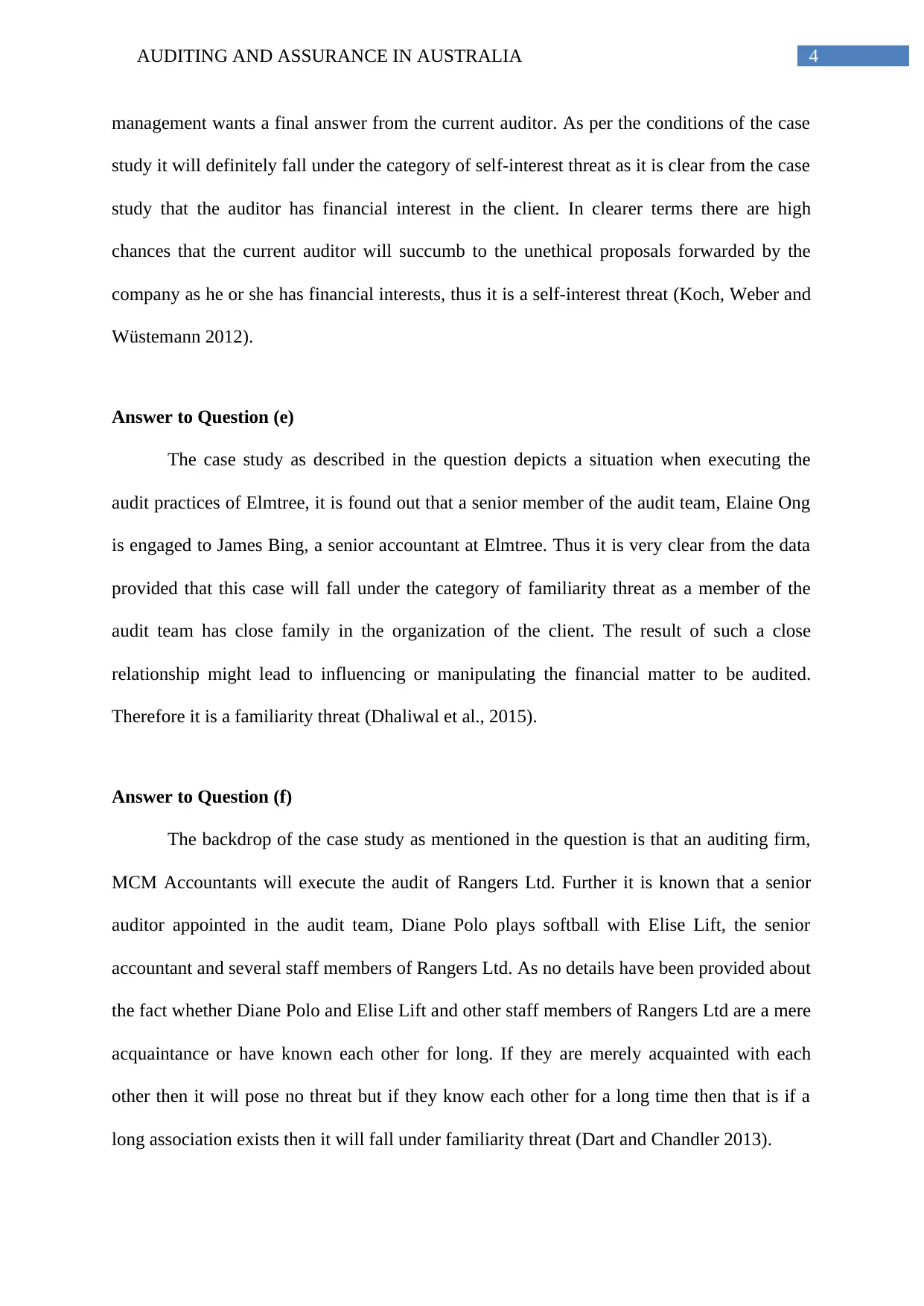
4AUDITING AND ASSURANCE IN AUSTRALIA
management wants a final answer from the current auditor. As per the conditions of the case
study it will definitely fall under the category of self-interest threat as it is clear from the case
study that the auditor has financial interest in the client. In clearer terms there are high
chances that the current auditor will succumb to the unethical proposals forwarded by the
company as he or she has financial interests, thus it is a self-interest threat (Koch, Weber and
Wüstemann 2012).
Answer to Question (e)
The case study as described in the question depicts a situation when executing the
audit practices of Elmtree, it is found out that a senior member of the audit team, Elaine Ong
is engaged to James Bing, a senior accountant at Elmtree. Thus it is very clear from the data
provided that this case will fall under the category of familiarity threat as a member of the
audit team has close family in the organization of the client. The result of such a close
relationship might lead to influencing or manipulating the financial matter to be audited.
Therefore it is a familiarity threat (Dhaliwal et al., 2015).
Answer to Question (f)
The backdrop of the case study as mentioned in the question is that an auditing firm,
MCM Accountants will execute the audit of Rangers Ltd. Further it is known that a senior
auditor appointed in the audit team, Diane Polo plays softball with Elise Lift, the senior
accountant and several staff members of Rangers Ltd. As no details have been provided about
the fact whether Diane Polo and Elise Lift and other staff members of Rangers Ltd are a mere
acquaintance or have known each other for long. If they are merely acquainted with each
other then it will pose no threat but if they know each other for a long time then that is if a
long association exists then it will fall under familiarity threat (Dart and Chandler 2013).
management wants a final answer from the current auditor. As per the conditions of the case
study it will definitely fall under the category of self-interest threat as it is clear from the case
study that the auditor has financial interest in the client. In clearer terms there are high
chances that the current auditor will succumb to the unethical proposals forwarded by the
company as he or she has financial interests, thus it is a self-interest threat (Koch, Weber and
Wüstemann 2012).
Answer to Question (e)
The case study as described in the question depicts a situation when executing the
audit practices of Elmtree, it is found out that a senior member of the audit team, Elaine Ong
is engaged to James Bing, a senior accountant at Elmtree. Thus it is very clear from the data
provided that this case will fall under the category of familiarity threat as a member of the
audit team has close family in the organization of the client. The result of such a close
relationship might lead to influencing or manipulating the financial matter to be audited.
Therefore it is a familiarity threat (Dhaliwal et al., 2015).
Answer to Question (f)
The backdrop of the case study as mentioned in the question is that an auditing firm,
MCM Accountants will execute the audit of Rangers Ltd. Further it is known that a senior
auditor appointed in the audit team, Diane Polo plays softball with Elise Lift, the senior
accountant and several staff members of Rangers Ltd. As no details have been provided about
the fact whether Diane Polo and Elise Lift and other staff members of Rangers Ltd are a mere
acquaintance or have known each other for long. If they are merely acquainted with each
other then it will pose no threat but if they know each other for a long time then that is if a
long association exists then it will fall under familiarity threat (Dart and Chandler 2013).
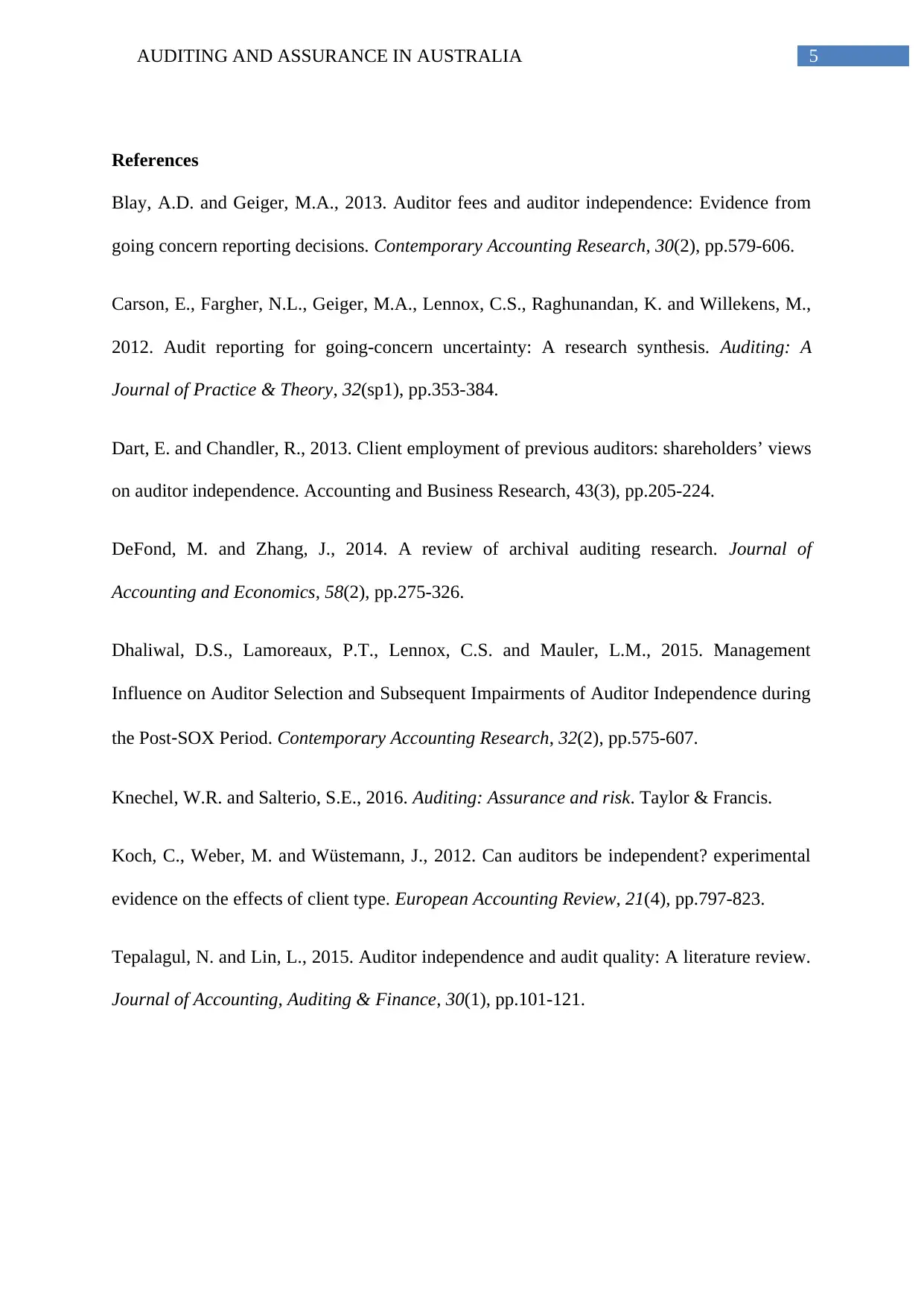
5AUDITING AND ASSURANCE IN AUSTRALIA
References
Blay, A.D. and Geiger, M.A., 2013. Auditor fees and auditor independence: Evidence from
going concern reporting decisions. Contemporary Accounting Research, 30(2), pp.579-606.
Carson, E., Fargher, N.L., Geiger, M.A., Lennox, C.S., Raghunandan, K. and Willekens, M.,
2012. Audit reporting for going-concern uncertainty: A research synthesis. Auditing: A
Journal of Practice & Theory, 32(sp1), pp.353-384.
Dart, E. and Chandler, R., 2013. Client employment of previous auditors: shareholders’ views
on auditor independence. Accounting and Business Research, 43(3), pp.205-224.
DeFond, M. and Zhang, J., 2014. A review of archival auditing research. Journal of
Accounting and Economics, 58(2), pp.275-326.
Dhaliwal, D.S., Lamoreaux, P.T., Lennox, C.S. and Mauler, L.M., 2015. Management
Influence on Auditor Selection and Subsequent Impairments of Auditor Independence during
the Post‐SOX Period. Contemporary Accounting Research, 32(2), pp.575-607.
Knechel, W.R. and Salterio, S.E., 2016. Auditing: Assurance and risk. Taylor & Francis.
Koch, C., Weber, M. and Wüstemann, J., 2012. Can auditors be independent? experimental
evidence on the effects of client type. European Accounting Review, 21(4), pp.797-823.
Tepalagul, N. and Lin, L., 2015. Auditor independence and audit quality: A literature review.
Journal of Accounting, Auditing & Finance, 30(1), pp.101-121.
References
Blay, A.D. and Geiger, M.A., 2013. Auditor fees and auditor independence: Evidence from
going concern reporting decisions. Contemporary Accounting Research, 30(2), pp.579-606.
Carson, E., Fargher, N.L., Geiger, M.A., Lennox, C.S., Raghunandan, K. and Willekens, M.,
2012. Audit reporting for going-concern uncertainty: A research synthesis. Auditing: A
Journal of Practice & Theory, 32(sp1), pp.353-384.
Dart, E. and Chandler, R., 2013. Client employment of previous auditors: shareholders’ views
on auditor independence. Accounting and Business Research, 43(3), pp.205-224.
DeFond, M. and Zhang, J., 2014. A review of archival auditing research. Journal of
Accounting and Economics, 58(2), pp.275-326.
Dhaliwal, D.S., Lamoreaux, P.T., Lennox, C.S. and Mauler, L.M., 2015. Management
Influence on Auditor Selection and Subsequent Impairments of Auditor Independence during
the Post‐SOX Period. Contemporary Accounting Research, 32(2), pp.575-607.
Knechel, W.R. and Salterio, S.E., 2016. Auditing: Assurance and risk. Taylor & Francis.
Koch, C., Weber, M. and Wüstemann, J., 2012. Can auditors be independent? experimental
evidence on the effects of client type. European Accounting Review, 21(4), pp.797-823.
Tepalagul, N. and Lin, L., 2015. Auditor independence and audit quality: A literature review.
Journal of Accounting, Auditing & Finance, 30(1), pp.101-121.
⊘ This is a preview!⊘
Do you want full access?
Subscribe today to unlock all pages.

Trusted by 1+ million students worldwide
1 out of 6
Related Documents
Your All-in-One AI-Powered Toolkit for Academic Success.
+13062052269
info@desklib.com
Available 24*7 on WhatsApp / Email
![[object Object]](/_next/static/media/star-bottom.7253800d.svg)
Unlock your academic potential
Copyright © 2020–2025 A2Z Services. All Rights Reserved. Developed and managed by ZUCOL.





